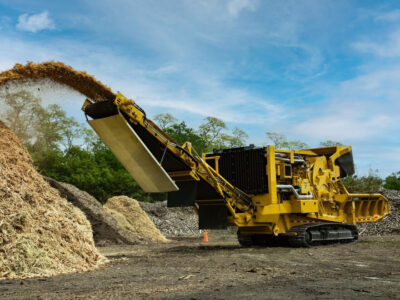When investing in a horizontal grinder, the one question everyone has is: “What size should I get?” You want to choose a model capable of keeping up with your production requirements, but not one so big that it’s overkill for your company’s needs and operations. The right-sized horizontal grinder will maximize your operational efficiencies while optimizing your employees’ time.
So where should you begin?
“Where the work is being done, the anticipated throughput volume and hours of operations are the three things I tell customers they should consider when determining what size of horizontal grinder is right for their needs,” said Ted Dirkx, sales manager for Environmental Solutions at Vermeer. “These three factors are key to ensuring they invest the best-sized equipment for their needs.”
Horizontal grinder applications
According to Dirkx, you should start your search for the right-sized machine by looking at where the work is being done. “I ask people if they intend to use their grinder at one location or if they plan to haul it up and down the road frequently,” he explained. “Now, some people think that if they’re going to be transporting it frequently, they want a smaller model — like the Vermeer HG4000 horizontal grinder — instead of something larger like the Vermeer HG6800TX horizontal grinder. But often the opposite is true. If you’re going to be hauling the grinder a lot, that usually means you’re using it on land clearing projects or you’re doing contract grinding for other facilities. For this type of work, production rates are a high priority, so going with a high horsepower, large capacity grinder will help crews maximize production efficiencies so they can move on to the next project faster.”
However, Dirkx says that before going all in on the largest machine you can purchase, you should consider the area of operations. “If crews are transporting grinders around narrow streets or congested city environments, they may need to think about the travel dimensions of their grinder more. At Vermeer, transportability is an important factor when we’re designing and developing horizontal grinders. In fact, our customers often say Vermeer grinders are built for transporting.”
Now, if you’re recycling wood waste to make mulch or compost, project timelines may not be as deadline oriented. So, you may want to consider a smaller-sized model for your needs, depending on your production volume and labor use goals.
Production goals
The next factor for sizing a horizontal grinder is your production goals.
- How much volume of material is your facility taking in?
- How much available land do you have for collecting and stacking incoming material?
- What kind of demand do you have for the end products being produced?
These are the questions Dirkx says should be considered when developing production goals. “Larger, higher horsepower grinders are going to have higher volumes of throughput on a daily basis,” he explained. “These numbers are important at facilities that need to process a lot of material to reduce product sizing, or their end products are in high demand.”
If your facility doesn’t match that description and you don’t feel the urgency to process material as quickly as possible, choosing a small horizontal grinder may be a more economical choice. These units can still handle a similar size and density of material, but at a slower pace.
Labor considerations
Another thing you may want to consider when choosing the right-sized equipment for your needs is the size of your team. Do you plan to have dedicated operators grinding material daily, or do you plan to grind a few days a week and have your team perform other tasks when the grinder is not in operation?
“Labor is an important factor to consider when choosing a horizontal grinder,” said Dirks. “At many facilities, especially in areas where it’s a challenge to find qualified help, a facility may choose to only grind a few days a week or during certain times of the year. So, to maximize their production, they go with a large model. This approach allows them to get by with fewer people performing a wider range of work.”
Meanwhile, other facilities prefer to have a dedicated workforce throughout each phase of their operation. If this describes your business approach, you may not need the largest horizontal grinder available.
Balanced decision
“It’s all about finding the right balance,” Dirkx concluded. “There is no one-size horizontal grinder for a particular application, facility size or even production goal. Instead, operations need to determine what their priorities are and choose the machine that will optimize throughput and operate efficiently throughout its service life.”
Need help talking through the details of choosing the right-sized horizontal grinder to invest in? Then contact a Vermeer dealer. They can provide a bit of guidance throughout the process and walk you through models you may want to consider.
Vermeer Corporation reserves the right to make changes in product engineering, design and specifications; add improvements; or discontinue manufacturing or distribution at any time without notice or obligation. Equipment shown is for illustrative purposes only and may display optional accessories or components specific to their global region. Please contact your local Vermeer dealer for more information on machine specifications.
Vermeer and the Vermeer logo are trademarks of Vermeer Manufacturing Company in the U.S. and/or other countries. © 2022 Vermeer Corporation. All Rights Reserved.
